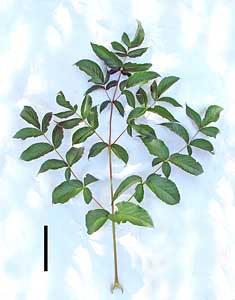Araliaceae: Aralia hispida Vent.
(bristly sarsaparilla)
Aralia hispida is a perennial, rhizomatous herb occurring in dryish, open woods and proliferating on recently cleared or burned forest land. It has alternate, twice pinnate leaves. Stems have strong bristly hairs near their base (hispidus is Latin for rough). The plant can reach a meter or more in height. In Nova Scotia, flowers open in July. Small, 5 parted, white flowers are borne in simple umbels on a long, corymb-like inflorescense. The flowers are bisexual but function first as males; then petals and anthers abscise and, in some flowers only, styles elongate and fulfill the female function.1 Aralia hispida is common throughout Nova Scotia. It occurs in all provinces from Newfoundland west to Alberta and in the eastern U.S. down to North Carolina.
Sources | Notes & Refs | Selected Web Resources | Line Drawing
Click on images for larger versions.
|
March 11, 2007. Halifax County: Point Pleasant Park (Halifax). Photographer: JackPine.
|
 |
 |
|
June 27 & July10, 2007. Halifax County: Point Pleasant Park (Halifax). Photographer: JackPine.
|
 |
 |
|
Aug 4, 2005. Halifax County: Point Pleasant Park (Halifax). Photographer: JackPine. Notes
|
 |
 |
|
Sep. 11, 2006. Halifax County: Point Pleasant Park (Halifax). Photographer: JackPine.
|
 |
 |

Bar is 1 cm |

Bar is 5 mm |

Bar is 10 cm |

Bar is 1 cm |
Selected Web Resources
- Taxonomic Status (ITIS)
Copy the species name above and paste it into a form on this ITIS Canada page to confirm the nomenclature and list synonyms.
- NatureServe Explorer Copy the species name above and paste it into a form on this page to view a map of its distribution within North America and its conservation status by province and state.
Notes & References
- Thomson, J.D. et al. 1989. Temporal patterns of nectar and pollen production in Aralia
Hispida: implications for reproductive success.
Ecology 70(4) 1989: 1061-1068.













